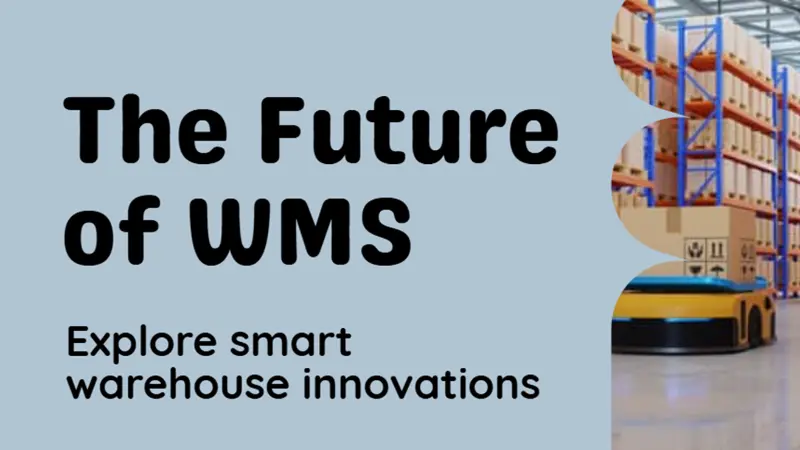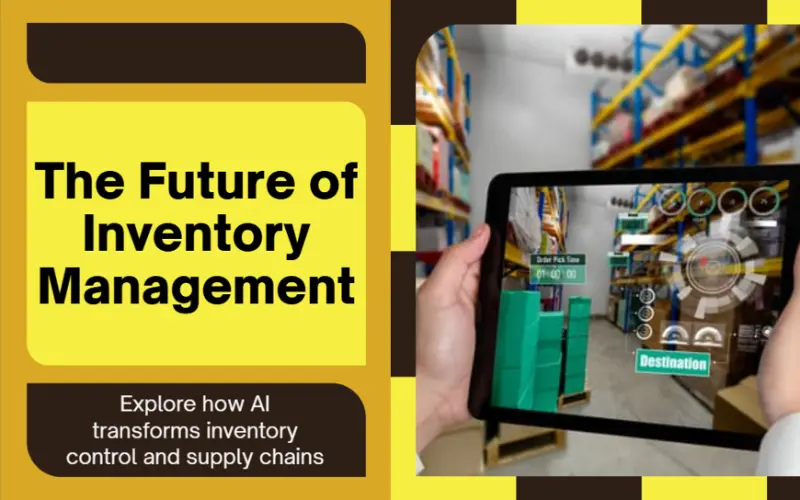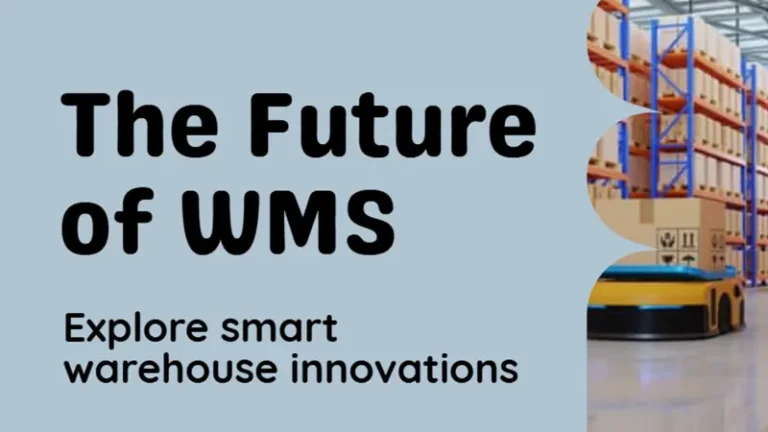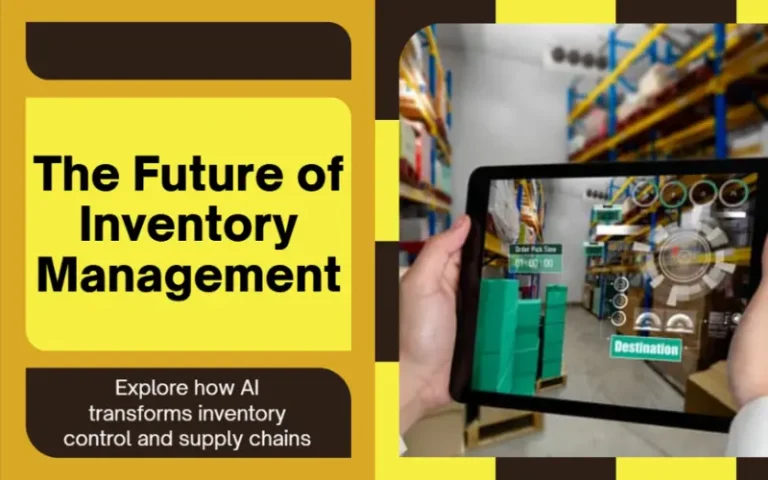The Future of the Warehouse Management System
Warehouses used to be about space and labor. Now, they’re becoming intelligent ecosystems powered by software, robotics, and real-time data. I’ve seen these changes firsthand, and the future of warehouse management systems (WMS) is more transformative than most expect.
From Storage Facilities to Smart Hubs
For years, warehouses were seen as cost centers, boxes in, boxes out. The rise of ecommerce, omnichannel fulfillment, and customer expectations for lightning-fast delivery have turned them into strategic assets. The warehouse environment is evolving into an intelligent, automated, and predictive space, where advanced technologies and integrated systems are transforming traditional warehousing into a future-ready hub that proactively responds to operational needs. The future of WMS reflects that shift: from a system that just tracks inventory locations to a command hub that optimizes every movement, every process, and every decision inside the four walls, and often beyond.
The rise of ecommerce and omnichannel fulfillment has accelerated this transformation. Modern supply chains are driving the need for flexible, automated, and sustainable warehousing solutions to meet evolving demands and improve efficiency.
When I walk into a modern warehouse today, it’s not just racks and forklifts. It’s sensors, automated storage systems, and a WMS orchestrating thousands of micro-decisions in real time. Modern warehouses incorporate advanced, automated technologies such as autonomous robots, AI, and scalable storage systems to transform operations into highly efficient, data-driven environments. That’s where the industry is heading, and those not adapting will struggle to compete. The future warehouse will be shaped by advancements like AI, robotics, IoT, and sustainability, creating smarter, more adaptable hubs for the supply chain.
A WMS orchestrating thousands of micro-decisions in real-time relies on seamless integration between WMS and automation technologies, enabling real-time data sharing and smooth operation across robotics, IoT, and inventory management systems.
Slash Your Fulfillment Costs by Up to 30%
Cut shipping expenses by 30% and boost profit with Cahoot's AI-optimized fulfillment services and modern tech —no overheads and no humans required!
I'm Interested in Saving Time and MoneyThe Automation Surge
Automation is no longer a niche experiment; it’s mainstream. Robotics, automated storage and retrieval systems, autonomous mobile robots (AMRs), and conveyor automation are becoming standard features in competitive warehouses. The WMS is the brain connecting these automated systems with human workflows. Warehouse automation solutions, including AI-driven robotics and predictive analytics, are transforming warehouse operations by increasing efficiency, accuracy, and enabling proactive management.
I’ve witnessed systems where robots handle inbound pallets, AMRs shuttle goods to pickers, and conveyors route orders to the right pack station, all directed by the WMS. Automation solutions and automation technologies enable smarter, more efficient, and increasingly autonomous operations. The results were striking: reduced labor requirements, improved inventory accuracy, and faster throughput. Automation systems and automation tools help streamline operations, reduce human error, and deliver significant cost savings. According to recent industry analysis, automation adoption in warehouses is expected to double by 2027, with companies citing labor shortages and rising operational costs as key drivers. This isn’t just about replacing people; it’s about enabling operational efficiency at scale, as advanced robots like AMRs operate independently of warehouse employees, reducing the need for manual labor in transportation and operational tasks.
AI and Predictive Operations
Like other parts of the supply chain, machine learning is changing warehouse management. Predictive analytics and AI-powered systems are transforming warehouse management by enabling demand forecasting and operational optimization, allowing businesses to anticipate needs and respond proactively. AI-powered WMS platforms can forecast demand surges and pre-position inventory, dynamically adjust picking routes based on current conditions, and even predict equipment maintenance needs before breakdowns occur.
In one warehouse I consulted for, AI-driven slotting recommendations, powered by artificial intelligence and AI systems that leverage historical data and real-time information, helped optimize resource utilization and optimize operations, cutting picker travel distance by nearly 30% and saving hours per shift. Predictive maintenance alerts from IoT sensors reduced downtime dramatically. Intelligent automation, which combines robotics, machine learning, and real-time data, enables self-optimizing processes and improves efficiency. These aren’t theoretical benefits; they’re happening now, and optimizing warehouse operations through predictive analytics and AI will be essential for future competitiveness.
Real-Time Visibility Everywhere
A modern WMS provides real-time data analytics that extend beyond the warehouse walls. Integration with enterprise resource planning, transportation management systems, and other supply chain technologies enhances both inventory visibility and supply chain visibility, giving businesses a comprehensive, real-time view of inventory and operations. It connects with suppliers, carriers, and other nodes in the supply chain to give a live picture of inventory and operations. This transparency allows businesses to respond instantly to disruptions or opportunities.
For example, if a carrier delay threatens to miss a delivery window, the WMS can reprioritize picking and allocate inventory from a different distribution center. These capabilities are essential for managing global supply chains and coordinating multiple distribution centers. In the past, you might not have even known about the issue until the customer complained. Now, you can prevent the complaint altogether.
Looking for a New 3PL? Start with this Free RFP Template
Cut weeks off your selection process. Avoid pitfalls. Get the only 3PL RFP checklist built for ecommerce brands, absolutely free.
Get My Free 3PL RFPHuman-Centric Design in an Automated World
Automation doesn’t mean people disappear. In fact, the best future WMS platforms are designed to augment human workers, not replace them. Automation technologies are transforming the roles of warehouse employees, warehouse managers, and warehouse operators, changing how they interact with advanced systems and robotics on the warehouse floor. Wearables, voice-directed picking, and augmented reality interfaces are making jobs easier, faster, and safer, while also improving safety, ergonomics, and productivity on the warehouse floor. I’ve seen new employees trained in hours, not weeks, using AR-guided picking. It boosts productivity while reducing errors and fatigue, critical in a labor market where retention is a constant challenge.
Sustainability is also becoming a key design element. Modern WMS solutions optimize energy use, reduce waste, and help companies meet environmental goals. Sustainable practices, such as reducing energy consumption and optimizing space utilization and warehouse space, are becoming integral to modern warehouse management. Whether it’s minimizing travel inside the warehouse or tracking carbon impact per order, sustainability features are fast becoming part of operational excellence. Resource utilization is also improved through data-driven layout planning and automation.
Beyond Screens: The Interfaceless Warehouse
Warehouse management is shedding its reliance on traditional screens. The WMS of the future will guide work through voice commands, AR overlays, and context-aware prompts, not keyboards. Workers will receive tasks in real-time via headsets or smart glasses, confirming picks or moves verbally as they go. Supervisors will manage operations through simple commands like, “WMS, reprioritize outbound for carrier pickup in Dock 3.” Technology and automation tools, along with advanced warehouse management software, are enabling these new, intuitive interfaces for workers.
This approach slashes training time, reduces errors, and keeps teams focused on the floor, not on terminals. It’s the natural evolution of warehouse automation, pairing intelligent systems with seamless, human-friendly interfaces. As one warehouse manager told me, “Our best tech is the tech our people barely notice, it just works.”
Preparing for the Future of WMS
The future of WMS isn’t about one killer feature; it’s about a connected ecosystem where data, automation, and people work in harmony to deliver operational efficiency and customer satisfaction. Smart warehousing and future warehouses will rely on advanced inventory management, real-time inventory tracking, and the ability to optimize inventory levels to meet both customer demand and evolving customer demands.
- Invest in integration: Choose a WMS that connects seamlessly with OMS, inventory systems, and external partners; seamless integration is essential for transforming warehouse operations and ensuring that warehouses operate efficiently within modern supply chains.
- Start with targeted automation: Deploy AMRs or automated storage where ROI is clear, and scale from there.
- Leverage data actively: Use analytics, warehouse management software, and warehouse management systems to transform warehousing operations, enable real-time inventory tracking, and optimize inventory levels. Trust the insights, but validate them.
- Support your workforce: Provide tools that make their jobs easier and safer; retention and efficiency go hand in hand.
- Think network-wide: Ensure your WMS can handle multi-site operations and support distributed fulfillment models.
Warehouses will remain a critical competitive differentiator in commerce. The businesses that see their WMS as a strategic enabler, not just a system of record, will be positioned to thrive in the next decade. The future of warehouse management will be defined by the ability to adapt to evolving supply chains and leverage smart warehousing technologies.
Scaling Made Easy: Calis Books’ Fulfillment Journey
Learn how Calis Books expanded nationwide, reduced errors, grew sales while cutting headcount, and saved BIG with Cahoot
See Scale JourneyFrequently Asked Questions
What are the main trends shaping warehouse management systems?
Increased automation, AI-driven optimization, real-time visibility, human-centric design, and sustainability are leading trends.
How does AI improve WMS performance?
AI enhances slotting, labor planning, predictive maintenance, and dynamic workflow adjustments, improving efficiency and reducing costs.
Will warehouses become fully automated?
Full automation is unlikely in the near term. Expect a hybrid model where automation handles repetitive tasks, and humans focus on exceptions, quality, and complex processes.
What’s the role of real-time data in WMS?
It enables immediate decision-making, from rerouting inventory to managing disruptions, ensuring responsiveness and accuracy.
How can companies prepare for next-gen WMS?
Upgrade to integrated, cloud-based systems, invest in automation gradually, prioritize data quality, and focus on workforce enablement.

Turn Returns Into New Revenue
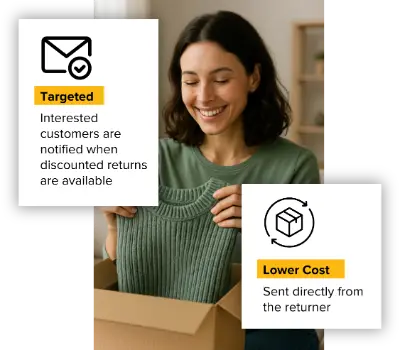
The Future of Inventory Management Software
In this article
 7 minutes
7 minutes
- From Counting Boxes to Predicting Demand
- HerAutomation That Stays Out of Your Waye
- Balancing Just-in-Time and Just-in-Case
- AI-Driven Operational Excellence
- The Invisible Interface: When Inventory Runs Itself
- The Data Layer: Real-Time, Everywhere
- Sustainability and the Human Factor
- Practical Takeaways for the Next Era
- Frequently Asked Questions
Inventory management software isn’t just tracking stock anymore. It’s becoming a predictive, automated, and quietly powerful force reshaping how we run supply chains. I’ve seen this shift up close, and it’s changing everything about how we manage inventory.
From Counting Boxes to Predicting Demand
Inventory management used to be simple: keep count, reorder when you run low, avoid the occasional stockout. That mindset doesn’t cut it anymore. Demand is unpredictable, supply chains are fragile, and customers expect “available now” at every touchpoint. The future of inventory management is predictive, not reactive.
I’ve watched AI-driven systems evolve from “nice-to-have analytics” to core operational engines. They don’t just show you inventory levels, they forecast demand weeks ahead by analyzing historical data, market trends, and even external factors like weather or influencer-driven social spikes. Retailers I’ve worked with are using predictive analytics to fine-tune replenishment, avoiding both stockouts and the drag of excess inventory. The real kicker? These systems learn as they go, getting sharper every season.
Slash Your Fulfillment Costs by Up to 30%
Cut shipping expenses by 30% and boost profit with Cahoot's AI-optimized fulfillment services and modern tech —no overheads and no humans required!
I'm Interested in Saving Time and MoneyAutomation That Stays Out of Your Way
The other big change: automation is becoming invisible. Nobody wants to micromanage replenishment orders or track inventory movement across multiple locations. Modern cloud based inventory systems handle that in the background. They create purchase orders, trigger warehouse transfers, and update sales channels automatically. You only hear from them when something’s wrong, like a supplier delay or a sudden demand spike.
This shift toward “zero-touch” inventory management is huge. I remember when daily inventory check-ins were a full-time job; now, advanced systems integrate directly with warehouse operations, ERP platforms, and even collaborative networks like Cahoot. If a warehouse in Texas has too much of a SKU and a Northeast DC is running low, the system can handle the transfer on its own. Less manual work, fewer errors, better customer satisfaction.
Balancing Just-in-Time and Just-in-Case
COVID-19 blew up the myth that lean inventory is always best. Businesses running purely just-in-time strategies got burned when supply chains faltered. The future lies in smarter inventory optimization, carrying enough buffer stock for resilience without sinking cash into overstock.
Today’s inventory management systems help you find that balance dynamically. They monitor supplier lead times, market conditions, and risk factors in real time, adjusting safety stock automatically. One fashion brand I’ve seen uses these tools to front-load seasonal items just enough to hedge against shipping delays, but not so much that they’re sitting on dead stock come spring. This kind of supply chain transparency and agility is where the competitive edge lives.
AI-Driven Operational Excellence
Machine learning isn’t just about forecasting; it’s improving every part of inventory management processes. Systems can now detect anomalies in inventory records (think mis-scanned pallets or missing raw materials) before they spiral into bigger problems. They optimize warehouse processes by recommending optimal slotting for high-velocity items, cutting picker travel time and costs. And they flag inefficient inventory-related tasks that waste labor.
Operational excellence in inventory management means more than cutting costs; it’s about speed, accuracy, and delivering on customer demand. Businesses that get this right see significant cost savings and improved customer satisfaction, which feeds directly into growth. If your software isn’t surfacing insights like “Item A is trending up, move it closer to outbound” or “Supplier B’s lead times are slipping, increase buffer,” you’re behind.
The Invisible Interface: When Inventory Runs Itself
The next leap isn’t just smarter software, it’s software that doesn’t need you staring at dashboards. Inventory systems are heading toward what I call a “zero-UI” experience. Instead of logging in daily to tweak reorder points, AI agents will work silently in the background, continuously analyzing historical data, current demand, and supply chain disruptions. You’ll only get a notification when action is truly required, like a supplier outage that threatens a key SKU.
This doesn’t mean losing control; it means shifting your role from button-pusher to decision-maker. Imagine saying, “System, show me this week’s high-risk items” and getting an instant, contextual answer. That’s where voice interfaces and AI explainability come in, you’ll trust these systems because they’ll tell you, in plain language, why they made a move. The most advanced cloud-based inventory systems already flirt with this capability. Soon, it will be standard.
Looking for a New 3PL? Start with this Free RFP Template
Cut weeks off your selection process. Avoid pitfalls. Get the only 3PL RFP checklist built for ecommerce brands, absolutely free.
Get My Free 3PL RFPThe Data Layer: Real-Time, Everywhere
Data is the foundation of modern inventory control. Real-time data analytics are no longer optional. IoT sensors in warehouses track inventory movement continuously. RFID tags give instant visibility across multiple locations. Cloud-based platforms integrate all that data into one live view, no more reconciling spreadsheets across departments.
This real-time layer enables better decisions everywhere. Marketing can plan promotions with confidence, knowing inventory status is accurate. Finance can forecast cash flow without guessing. Operations can reroute stock instantly when demand shifts. And with advanced algorithms, these systems aren’t just reporting data, they’re making sense of it, recommending actions that optimize inventory levels and overall operational efficiency.
Sustainability and the Human Factor
The future of inventory management isn’t only about efficiency; it’s also about responsibility. Modern systems are incorporating environmental monitoring, helping companies reduce waste, cut their carbon footprint, and align with sustainability goals. Think smarter replenishment to avoid expired goods, or optimized transport to minimize miles.
At the same time, minimal human intervention doesn’t mean no human oversight. The best systems keep people in the loop where it matters, strategy, exceptions, customer relationships, while handling the grunt work automatically. That’s the sweet spot: technology that empowers, not replaces.
Practical Takeaways for the Next Era
For anyone managing inventory today, here’s where to focus:
- Upgrade to cloud based inventory systems with robust integration. Legacy platforms can’t deliver real-time data or automation at scale.
- Use machine learning to improve forecasting and reduce excess inventory. Even a pilot can show quick wins.
- Reevaluate your inventory optimization strategy. Don’t rely solely on JIT; build resilience into your inventory levels.
- Prioritize data accuracy. Garbage in, garbage out, clean inventory data is the backbone of any system.
- Look beyond your four walls. Connect with partners, distribution centers, and networks like Cahoot to extend your reach without heavy investment.
The future of inventory management software isn’t about dashboards and manual processes. It’s about systems that quietly deliver operational excellence, let you manage inventory across multiple locations effortlessly, and give you a genuine competitive edge. I’ve seen companies transform their business by embracing these tools, and I believe that in a few years, they won’t be optional. They’ll be the standard.
Scaling Made Easy: Calis Books’ Fulfillment Journey
Learn how Calis Books expanded nationwide, reduced errors, grew sales while cutting headcount, and saved BIG with Cahoot
See Scale JourneyFrequently Asked Questions
What are the most important inventory management trends right now?
Predictive analytics, real-time visibility, and automation are leading. Companies are using AI to forecast demand, IoT to track inventory live, and cloud platforms to integrate operations across multiple locations.
How can AI improve inventory management?
AI helps forecast customer demand, optimize inventory levels, and automate repetitive tasks like replenishment and transfers, reducing human error and improving efficiency.
What’s the role of cloud-based inventory systems?
They provide a single, accurate view of inventory data across the business, enable real-time updates, and integrate seamlessly with other systems like OMS and WMS.
Should businesses still use just-in-time inventory?
Pure JIT is risky. The trend is toward balanced inventory optimization, lean where you can, buffered where you must, guided by real-time data and analytics.
How can inventory management software support sustainability?
By optimizing stock levels to reduce waste, improving transport efficiency, and providing transparency for sustainable sourcing and operations.

Turn Returns Into New Revenue

Tariffs Are About to Hit Your Ecommerce Business Hard
In this article
 8 minutes
8 minutes
- Key Takeaways
- What Just Changed, and When Exactly?
- Why This Feels Like a Total Ambush
- Why It’s Bigger Than Ecommerce
- Real-World Example: The Etsy Seller Nightmare
- Real Costs of Making Things in the U.S.
- Backlog, Delays & the Holiday Spiral
- The July Ecommerce Spike, Front-Loaded Inventory or Prime Day?
- Holding Costs Hit Hard
- Putting This in Perspective
- What Ecommerce Operators Must Do Now (Seriously)
- Bonus Insight: SMBs vs. Giants
- Frequently Asked Questions
Brace yourself. Today, August 29, 2025, the U.S. scraps the de minimis exemption, meaning even tiny low-cost international packages will now face tariffs. Yeah, that includes your $20 gadget or your $50 pair of drop-shipped sneakers, and it’s going to hurt.
Brace yourself. Effective today, August 29, 2025, the U.S. scraps the de minimis exemption, meaning even tiny low-cost international packages will now face tariffs. Yeah, that includes your $20 gadget or your $50 pair of drop-shipped sneakers, and it’s going to hurt. Not just ecommerce merchants, either. This is effectively a consumption tax hitting millions of households, retailers, and supply chains all at once, and it will ripple across the broader U.S. economy.
Key Takeaways
- Aug 29 launches tariffs on all low-value imports. No more duty exemption.
- Global postal avenues are paused. Customs is flooded. Delays are coming.
- Small merchants are squeezed. Bigger ones shored up with U.S. stock.
- Inventory strategies need an overhaul: storage, pricing, sourcing, and communications.
- Ecommerce penetration is weak. Margins are under attack. Adapt, or risk going under.
Slash Your Fulfillment Costs by Up to 30%
Cut shipping expenses by 30% and boost profit with Cahoot's AI-optimized fulfillment services and modern tech —no overheads and no humans required!
I'm Interested in Saving Time and MoneyWhat Just Changed, and When Exactly?
Starting today, Friday, August 29, 2025, any international shipment heading into the U.S. (nope, not just leaving origin), regardless of how cheap, will be slapped with new costs. You’re looking at 10% – 50% duties, or an $80 – $200 flat handling fee per package. That’s a massive operational change.
Timing-wise? It doesn’t matter if a package leaves just before midnight UTC; you’re still on the hook once it arrives or is processed on/after Aug 29. Customs doesn’t care about your origin timezone; they use U.S. entry or postmark dates.
Why This Feels Like a Total Ambush
OK, the Trump administration has been choreographing this move for many months now (and it started with President Biden in Q4 2024). But it’s also been postponed and postponed. So, everyone has been in “wait and see” mode. Now, mail services worldwide have freaked out. Postal carriers in Mexico, the EU, India, Australia, and more have halted or paused shipments to the U.S. due to confusion and a lack of tools for tariff collection. That’s not a minor blip; that’s a supply chain scream. Shouldn’t the infrastructure be in place long before the new legislation goes into effect?
And it’s not just online sellers who get squeezed. When customs systems clog up, that affects everyone: apparel retailers waiting on seasonal imports, tool distributors holding back orders, and even general merchandisers like Walmart or Target. Add it up and you’ve got a new inflation driver at the exact wrong time; households already pinched by high grocery and rent costs are now staring down higher prices on imports across the board.
Why It’s Bigger Than Ecommerce
It’s tempting to frame this as an ecommerce headache. It isn’t. It’s a systemic shock that touches the entire economy.
- Supply chains clog up → Customs delays don’t care if it’s an Etsy pin or 10,000 drills headed to Home Depot. Backups hit everyone.
- Inflation pressure rises → Tariffs are a tax. Higher landed costs mean higher shelf prices. Even if sellers eat some of it, retailers eventually pass it on, right into household budgets already stretched by food and rent inflation.
- Retail + logistics ripple → Apparel, electronics, packaged goods, any category that leaned on cheap overseas fulfillment just lost competitiveness. Logistics providers get caught in the crossfire, rerouting shipments and charging more.
- Macro slowdown risk → Stanford economists warn these tariffs will directly feed inflation, dragging down consumer confidence and GDP. That’s why Etsy and eBay shares tanked the moment the news broke. Investors know it’s not just about small packages; it’s about overall spending.
So when you see tariffs called a “new inflation driver,” don’t file it under “ecommerce news.” This is a broad economic headwind. Ecommerce just happens to be the first and most visible test case.
Real-World Example: The Etsy Seller Nightmare
Take a small Etsy artist selling enamel pins made overseas. Last week, a $15 order meant low shipping costs, zero customs, and a happy customer. Starting next week? The same $15 pin could hit $45 after tariffs, or get buried in customs for days. Many international sellers are shutting off U.S. listings entirely, just until clarity returns.
And it’s not just pins. The same math applies to low-value, high-volume imports like nail art kits, USB cables, or cheap toys. Tariffs don’t discriminate by category; they crush unit economics whenever a flat $80 – $200 fee gets applied to something that used to move freely.
Meanwhile, big dogs like Shein and Temu have been stockpiling U.S.-based inventory for weeks, preparing for this cyclone.
Looking for a New 3PL? Start with this Free RFP Template
Cut weeks off your selection process. Avoid pitfalls. Get the only 3PL RFP checklist built for ecommerce brands, absolutely free.
Get My Free 3PL RFPReal Costs of Making Things in the U.S.
Let’s zoom in and do quick math for some known commodities. These aren’t exact price tags but directional benchmarks that show the gap between import cost and known domestic production:
| Item | Imported Cost | Estimated Domestic Cost |
| Mid-weight hoodie | ~$25 | ~$50–$70 |
| Hand-held power tool | ~$40 | ~$75–$100 |
| External SSD, 1 TB | ~$80 | ~$120–$150 |
The signal here is clear: domestic manufacturing is usually 2 – 3x more expensive once you add labor, compliance, and overhead. Yes, you can avoid tariffs by making things in the U.S., but you’ll pay more upfront. Sellers face trade-offs: raise prices, squeeze margins, or rethink their product strategy entirely.
Think of it as a proxy for category pressure:
- Apparel → doubling costs devastates fast-fashion models.
- Tools → U.S.-made brands already command a premium; imports compete aggressively for a reason.
- Electronics → domestic production is scarce, so the gap highlights dependence on Asia.
The broader point: this isn’t just about “cheap junk.” It’s about core consumer categories: clothes, tools, computing gear, all facing pricing pressure at once.
You lose price edge, fast. U.S.-made quality might justify higher prices, but forget about competing in cost-sensitive categories like fashion, gadgets, or lifestyle gear.
Backlog, Delays & the Holiday Spiral
Customs is backed up. Delays of days or even weeks are likely. You may hear horror stories: “Your package got destroyed, no notification.” It’s not entirely apocryphal. With new rules and overwhelmed operations, no-shows (auto rejections, destroyed parcels) and zero follow-up are real concerns. Some carriers already operate that way.
Now imagine this creeps into the 2025 holiday season. Brands that didn’t front-load inventory by late summer are going to find empty virtual shelves and customer churn.
The July Ecommerce Spike, Front-Loaded Inventory or Prime Day?
July’s blistering sales? Maybe not entirely Prime Day hype. Anecdotally, a bunch of merchants ordered inventory early to dodge this tariff tsunami. So yes, July looks great, but many were just building stock coverage. That likely bumps Q4 cost‐of‐goods significantly and ties up cash for longer. Holding fees, insurance, longer fulfillment cycles… it all adds up.
Holding Costs Hit Hard
If you’re holding inventory earlier, expect your cost structure to morph. Here’s a quick breakdown of what’s eating at your margins:
- Storage fees (AKA “why am I paying more for shelf space?”)
- Capital tied up (less liquidity)
- Handling & restock labor
- Insurance + spoilage/obsolescence (trends shift faster now)
- Inventory management complexity (new SKUs, forecasting shifts)
- Risk of returns/refunds stretched over holiday returns windows
Those skinny margins, beloved by fast-fashion and gadget dropshippers? They might vanish this season.
Putting This in Perspective
Online sales are not booming. Ecommerce penetration has sunk back to about 10% of retail, pre-COVID levels. Discretionary purchases are flattening thanks to inflation. That candy bar that used to be $1 is now nearly $2.50. Same size. This change is just more pressure in a season where consumers are already cutting back.
Scaling Made Easy: Calis Books’ Fulfillment Journey
Learn how Calis Books expanded nationwide, reduced errors, grew sales while cutting headcount, and saved BIG with Cahoot
See Scale JourneyWhat Ecommerce Operators Must Do Now (Seriously)
Time to get your house in order. If you’re not already doing these, desperation may be coming:
1. Stock smarter: Factor in tariffs, delays, insurance, and storage. Build extended-lead-time buffers now.
2. Diversify sourcing: Nearshore, U.S. manufacturing, or multi-origin shipping. Don’t rely on one geography.
3. Update pricing transparently: Communicate customs fees to customers. No surprises = less churn.
4. Negotiate with carriers: Who can pre-clear customs, who can absorb duties, and who won’t? Don’t assume everyone’s the same.
5. Leverage warehousing: Hybrid models: overseas for baseline, U.S. warehouses for flexibility and safety stock.
6. Focus on community & retention: When acquisition costs rise, existing customers matter more. Think retention-driven, not growth-at-all-costs.
7. Keep margins visible: Use cash-first accounting. Know your true landed cost after fees, storage, and burn rates.
Bonus Insight: SMBs vs. Giants
Small margins and thin buffers mean many SMB stores in low-price tiers might not survive. At the same time, this plays directly into Cahoot’s DNA, and we help shift from fragility to resilience. If you’re watching costs inch tighter, it’s time to lean on the systems, automation, and planning muscle we built with you.
Frequently Asked Questions
When does the de minimis exemption end?
August 29, 2025, any international parcel processed or shipped on/after this date gets taxed.
What are the new 2025 tariff ranges?
10% – 50% of the value, or $80 – $200 flat fee for six months.
Can small sellers cancel U.S. shipping temporarily?
Yes, many are pausing until clarity returns. But remember that’s also lost revenue.
Is this just a shock or a lasting change?
Likely lasting. Reinstating de minimis would require substantial political pressure.
How should merchants communicate cost changes?
Be transparent. Use simple tooltips (“international duties may apply”) and clear shipping pages.

Turn Returns Into New Revenue

The Future of SaaS: From Feature Wars to Invisible Intelligence
The SaaS world is changing faster than most of us realize. For years, software companies competed in feature wars, packing in dashboards, toggles, and modules like they were stocking a buffet. The SaaS model has historically dominated the software industry, driving the ongoing SaaS revolution that continues to transform how businesses operate. Now? Businesses don’t want more features. They want results. They’re done with juggling complex tools; they want outcomes, automation, and systems that just work.
At Cahoot, working with ecommerce brands every day, we see this shift up close. Retailers are tired of logging into five different apps to ship a single order or analyze a single metric. Unlike traditional software, which required on-premise installation and significant upfront investment, cloud-based SaaS has enabled scalable, accessible solutions delivered over the internet. They want software that solves problems quietly, without adding to their workload. This shift is not only changing how software is delivered, but is also reshaping the overall SaaS landscape and business model for software companies. That’s where SaaS is heading: from feature-heavy to invisible intelligence, AI-powered systems that deliver results in the background.
Slash Your Fulfillment Costs by Up to 30%
Cut shipping expenses by 30% and boost profit with Cahoot's AI-optimized fulfillment services and modern tech —no overheads and no humans required!
I'm Interested in Saving Time and MoneyFrom Features to Outcomes: SaaS Grows Up
The feature-first era was inevitable. Competition exploded, and SaaS providers fought to stand out by adding more and more. It worked for a while. But now, the market is saturated. Enterprise buyers face dozens of options for every function. Most use only a fraction of the tools they pay for. Current SaaS trends show that, to stay competitive, companies are evolving their pricing models, moving away from the traditional pricing model toward more flexible, outcome-based pricing models that better align with customer value. The question isn’t “Which software has the most features?” anymore; it’s “Which solution gets me the result with the least effort?”
This is the evolution of SaaS: from tools to services, from dashboards to deliverables. The best SaaS companies today measure success not by logins, but by outcomes, higher conversion rates, lower churn, and faster operations. Reducing customer churn and improving customer retention are now key business outcomes for SaaS companies, and innovative revenue models are being adopted to support these goals. And the ones that can’t prove that? They’ll lose.
Recent research backs this up: 90% of enterprise buyers expect AI-driven functionality in their SaaS tools, and AI-enhanced products are growing revenue 10% faster than their traditional counterparts. As revenue growth rates slow across the industry, new pricing models and revenue models are directly impacting business outcomes and helping companies maintain a competitive edge. In short, outcome-driven SaaS isn’t a trend; it’s table stakes.
The Rise of AI-Driven, Invisible Software
We’re entering the age of “zero UI”, or more accurately, invisible UI. Instead of training employees to master endless dashboards, AI agents handle the work and surface only what matters. Artificial intelligence, with its advanced AI capabilities and sophisticated AI models, is the driving force behind this transformation, enabling software to operate autonomously and intelligently.
Picture an ecommerce ops manager today: they log into a shipping app, check carrier rates, process orders, and handle exceptions. In tomorrow’s SaaS world, they don’t log in at all. The system automatically selects the best carriers, schedules pickups, and sends alerts only if something goes wrong. The software is invisible, but the results are very visible: lower costs, on-time deliveries, happier customers. In this future, AI tools and AI-driven solutions will automate processes (and automate workflows), leveraging machine learning to generate insights and streamline software development for even greater efficiency.
This shift is already happening. AI copilots are appearing in everything from CRMs to project management tools, and they’re evolving into full AI agents capable of executing tasks autonomously. It’s a tech revolution. And it’s going to redefine what “software” even means. The rise of no-code platforms is also democratizing software development in the SaaS industry, empowering more users to build and automate workflows without traditional programming.
Looking for a New 3PL? Start with this Free RFP Template
Cut weeks off your selection process. Avoid pitfalls. Get the only 3PL RFP checklist built for ecommerce brands, absolutely free.
Get My Free 3PL RFPTrust, Transparency, and Control
With invisible intelligence comes a new challenge: trust. If software is making decisions behind the scenes, approving refunds, reallocating inventory, users need confidence that it’s doing the right thing. Security concerns are paramount, as risks such as data breaches highlight the need to protect sensitive data (e.g., customer data) from unauthorized access and cyber threats.
The future belongs to SaaS platforms that balance automation with transparency. That means:
- Providing simple, plain-language explanations for AI-driven actions (“Shifted 200 units to avoid stockout based on forecasted demand”).
- Allowing selective oversight, logs, override options, and compliance safeguards.
- Ensuring data security and bias mitigation to build long-term trust.
- Implementing robust network security and secure cloud infrastructure to safeguard business data and maintain compliance.
In ecommerce and logistics, this is critical. Brands will only rely on AI to run fulfillment or manage customer interactions if they can see that the system is accurate, secure, and aligned with their goals.
Vertical SaaS: Smarter by Design
The shift to invisible, outcome-first SaaS is accelerating the rise of vertical SaaS, industry-specific platforms that deliver deep, tailored value. Generic tools can’t match the precision of a solution built for your exact challenges, especially when AI is layered in. Vertical SaaS solutions leverage business intelligence, data intelligence, and cloud-based solutions to address specific customer needs, enabling organizations to operate more efficiently and make smarter decisions.
We’re already seeing vertical SaaS leaders in ecommerce fulfillment, healthcare, and finance outperform broad, horizontal platforms. Why? Because domain-specific AI can optimize in ways generic software can’t. Cloud computing, customer experience, and customer engagement are central to these advancements, ensuring that SaaS solutions deliver maximum value through seamless integration and real-time responsiveness. For example, an AI-driven shipping platform can anticipate carrier rate changes, reroute shipments preemptively, and minimize costs automatically. That’s the kind of invisible intelligence ecommerce brands are asking for, and the kind Cahoot is building into our own solutions. Customer relationship management and creating exceptional customer experiences are now essential for vertical SaaS providers to drive loyalty and long-term growth.
Too Many Tools? AI Could Be the Fix
Ironically, while SaaS aims to simplify, businesses have never had more tools. Many manage dozens, sometimes hundreds, of separate applications. This leads to data silos, wasted spend, and operational drag. The complexity of managing diverse tech stacks and fragmented SaaS applications creates additional challenges for organizations seeking streamlined workflows and effective digital transformation.
AI could be the unifier. Instead of humans stitching everything together, intelligent agents will coordinate across multiple systems, pulling data, triggering actions, and delivering outcomes seamlessly. APIs will become the backbone; AI will be the brain. This integration not only improves operational efficiency but also supports business success by enabling proactive management and better customer outcomes. For ecommerce, that might mean one integrated solution managing orders, inventory, shipping, and returns with minimal human touch, replacing a patchwork of disconnected apps.
As the SaaS landscape evolves, business models of SaaS vendors are shifting, with the rise of micro SaaS targeting niche needs and impacting both public SaaS companies and broader SaaS businesses.
The Road Ahead: Adapt or Fall Behind
SaaS isn’t disappearing. It’s becoming something more powerful and more invisible. The winners will be those who combine AI’s adaptability with SaaS’s reliability, delivering measurable results without adding complexity. This reflects an ongoing paradigm shift in the SaaS market, where AI-driven solutions and innovative SaaS products are redefining how organizations operate and deliver maximum value.
For businesses, the takeaway is clear: start evaluating your tools not by how many features they have, but by how little work they leave for you. Leverage business data to drive better business outcomes, as highlighted in recent market research from Fortune Business Insights. Pilot AI-driven capabilities. Demand transparency and vertical expertise. And prepare for a world where software works quietly in the background, letting you focus on strategy, not screens.
Looking ahead, the growing importance of sustainable practices and achieving net-zero residual emissions will play a key role in shaping the future of SaaS.
Frequently Asked Questions
What Is “Invisible” SaaS and Why Does It Matter?
Invisible SaaS refers to AI-powered software that operates in the background, handling tasks automatically and surfacing only results. It matters because it reduces complexity and improves outcomes without adding to users’ workloads.
Will AI Replace Traditional SaaS Platforms?
Not entirely. AI will augment and automate many SaaS functions, but core platforms will remain as secure, reliable backbones. The future is AI-enhanced SaaS, not AI-only.
How Can Ecommerce Brands Prepare for This Shift?
Audit where you’re spending time on manual processes, test AI-enabled features from your current providers, and focus on tools that demonstrate real, measurable results.
Why Is Vertical SaaS Becoming More Important?
Industry-specific solutions with embedded AI can deliver better outcomes than generic platforms by leveraging domain expertise and tailored automation.
What Risks Should Businesses Watch in AI-Driven SaaS?
Watch for data security, transparency, and potential bias in AI decisions. Choose vendors with clear safeguards, compliance certifications, and explainable AI practices.

Turn Returns Into New Revenue

Top 10 Best Inventory Tracking Software to Streamline Your Business
In this article
 15 minutes
15 minutes
- Key Takeaways
- Why Inventory Tracking Software is Essential
- Key Features to Look For in Inventory Tracking Software
- Top 10 Inventory Tracking Software Solutions
- How to Choose the Right Inventory Tracking Software
- Inventory Tracking for Returns
- Benefits of Using Dedicated Inventory Tracking Software
- Common Challenges in Inventory Management
- Tips for Maximizing the Use of Inventory Tracking
- Software
- Top Uses for AI and Advanced Technologies in Inventory Tracking Software
- Summary
- Frequently Asked Questions
As businesses scale and sell across more channels, inventory tracking becomes increasingly complex. The right software helps streamline operations, prevent stockouts, and keep customers happy with accurate, real-time data. Today’s top platforms offer features like barcode scanning, demand forecasting, and integrations with ecommerce and accounting systems. In this article, we review the best inventory tracking software options for 2025 to help you find a solution that matches your needs, budget, and growth goals—whether you’re managing a warehouse, a retail store, or a multichannel online business.
Key Takeaways
- Investing in inventory tracking software automates stock management, improves operational efficiency, and reduces human errors, allowing businesses to respond quickly to market demands.
- Key features to consider when selecting inventory software include real-time monitoring, barcode scanning, automated reordering, and seamless integration with other business systems.
- Thoroughly assess your specific business needs, compare different software pricing and plans, and evaluate integration capabilities to choose the right inventory tracking solution for your operations.
Slash Your Fulfillment Costs by Up to 30%
Cut shipping expenses by 30% and boost profit with Cahoot's AI-optimized fulfillment services and modern tech —no overheads and no humans required!
I'm Interested in Saving Time and MoneyWhy Inventory Tracking Software is Essential
Manually tracking stock levels, sales, and item locations is near-impossible. Inventory management software automates all the tasks and provides real-time data on inventory levels, orders, and deliveries. This not only boosts operational efficiency but also minimizes costly human errors.
Real-time data access is vital for making prompt and informed decisions. Knowing your exact inventory across multiple locations at any moment allows quick responses to changes in demand, preventing stockouts and overstock. These platforms help businesses maintain market accuracy and competitiveness, ensuring customer demands are met efficiently.
Choosing the right inventory management tool can greatly impact your business’s success. Effective inventory control goes beyond knowing stock levels; it optimizes the entire supply chain. The right software streamlines operations, cuts costs, and improves the bottom line.
Key Features to Look For in Inventory Tracking Software
Selecting inventory tracking software requires focusing on features that support your business needs. Real-time monitoring allows immediate tracking of stock levels across various locations. This keeps inventory data current, facilitates better decision-making, and helps avoid discrepancies.
Barcode scanning is another key feature that can streamline your inventory processes. By using digital labeling and barcode scanners, you can improve data entry accuracy and speed up inventory checks. This reduces human error and makes inventory counts more efficient.
Automated reordering maintains optimal stock levels by alerting you when inventory dips below a certain threshold, thus preventing stockouts.
Your inventory management software should seamlessly connect with systems like accounting software, CRM, and ecommerce platforms. This synchronization ensures a comprehensive operational workflow.
Mobile device support is valuable, enabling inventory management on the go via apps designed for smartphones and tablets.
Top 10 Inventory Tracking Software Solutions
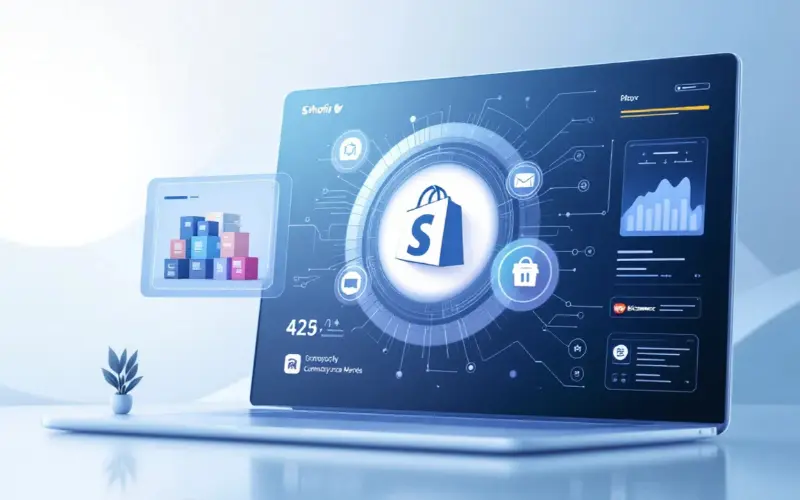
Choosing the right inventory tracking software can be overwhelming with so many options available. We’ve compiled a list of the top 10 solutions based on features, ease of use, and overall effectiveness in managing inventory to help you navigate the choices.
From Pulse Commerce to BlueTally, each software offers unique capabilities that cater to different business needs. Whether you’re a small business looking for a user-friendly interface or a larger enterprise needing advanced features, there’s something here for everyone.
Let’s dive into the details of each software solution.
Pulse Commerce
Pulse Commerce’s Inventory Management system offers businesses real-time visibility across all stores, warehouses, and fulfillment centers, ensuring accurate tracking of inventory levels and reducing stock-outs. This centralized view enables companies to make informed decisions, optimize stock distribution, and enhance overall operational efficiency. Additionally, the system’s robust APIs facilitate seamless integration with warehouse management and point-of-sale systems, capturing real-time inventory updates, including returned items.
The platform supports multi-location inventory and barcoding, allowing businesses to maintain a centralized, real-time view of all inventory across various fulfillment centers and stores. This feature enhances inventory accuracy and streamlines warehouse operations by enabling real-time tracking with barcode scanners in both warehouses and retail locations. Furthermore, the system efficiently manages back orders and drop shipments, tracking all shipments and creating daily exception reports to focus on orders requiring immediate attention. And it offers a range of features like intelligent order routing, real-time inventory visibility, and multi-location inventory tracking.
Pulse Commerce’s Inventory Management system also includes a built-in Product Information Management (PIM) feature, which encompasses product catalog taxonomy, data quality, attribute management, and data synchronization across channels. This ensures consistency and accuracy of product information across all sales channels, enhancing the customer experience and reducing errors. By integrating these comprehensive inventory management capabilities, businesses can optimize their operations, improve customer satisfaction, and drive growth.
Zoho Inventory
Zoho Inventory stands out for its real-time stock tracking and seamless integration with major platforms like Shopify and Amazon. This makes it an excellent choice for businesses that operate across multiple ecommerce platforms. Moreover, Zoho Inventory integrates well with Zoho’s suite of business apps, providing a cohesive ecosystem for managing various aspects of your business.
Zoho Inventory is particularly appealing to small businesses, offering a free plan for up to 50 orders per month. Its intuitive interface and features, such as multi-warehouse management, streamline operations, enabling businesses to focus on growth.
Cin7
Cin7 is known for its end-to-end inventory management capabilities, making it robust for businesses of all sizes. It provides real-time tracking, order management, and automated stock replenishment, ensuring optimized inventory levels. Cin7 supports multiple sales channels, warehouses, and currencies, offering the flexibility needed for effective multi-location management.
The platform’s automation features significantly streamline workflows, reducing manual errors and enhancing overall efficiency. With over 100 detailed reports, Cin7 provides deep insights into your inventory operations, helping you make informed decisions. Its scalability makes it suitable for multichannel retailers, wholesalers, and manufacturers.
Fishbowl Inventory
Fishbowl Inventory is particularly well-suited for medium-sized businesses, offering advanced order management features and seamless integration with QuickBooks. This integration enhances both accounting and inventory management processes, providing a unified system for better control. Fishbowl’s multi-location tracking capabilities ensure that your inventory data is always up-to-date across different sites.
Advanced features like real-time tracking and automated stock replenishment help businesses maintain optimal inventory levels. Fishbowl Inventory caters to medium-sized businesses, providing tools for efficient and organized inventory handling.
Ordoro
Ordoro excels in streamlining inventory management, order fulfillment, and shipping processes by aggregating orders from multiple sales channels into a single interface, simplifying order processing and management. This feature is particularly beneficial for businesses that operate across various ecommerce platforms.
One of Ordoro’s standout features is its ability to increase average order value through kitting and bundling options. These features allow businesses to create product bundles that can be sold as a single unit, enhancing sales opportunities.
Ordoro’s comprehensive order management capabilities make it a valuable tool for businesses looking to optimize their inventory and order processes.
Katana
Katana’s software offers real-time tracking of raw materials and finished products, supported by detailed insights dashboards. This visibility enables effective inventory management and quick responses to changes in demand. Katana also optimizes production scheduling and resource allocation, reducing costs and boosting efficiency.
The platform supports tracking inventory across up to three warehouses simultaneously, making it suitable for businesses with multiple locations. Additionally, Katana tracks labor costs and productivity, helping businesses stay informed about their expenses. Its ability to create purchase orders directly within the software facilitates efficient procurement and inventory management.
Veeqo
Veeqo simplifies inventory management by automating levels across multiple online sales platforms. This automation reduces manual tasks and increases efficiency, allowing businesses to focus on growth. Veeqo’s features make it an excellent choice for businesses that sell across various ecommerce platforms. However, Veeqo is owned by Amazon, so you’ll have to be comfortable giving all your data to the marketplace giant.
Unleashed
Unleashed provides comprehensive reporting through its Business Intelligence dashboard, offering real-time visibility into stock levels. This visibility allows businesses to manage inventory more effectively, ensuring that stock levels are always optimized. The software’s unlimited warehouse feature is particularly beneficial for businesses looking to expand geographically.
With a high user rating on Trustpilot, Unleashed is a trusted solution for businesses looking to scale their operations efficiently. It integrates seamlessly with various ecommerce, accounting, and CRM systems like Xero, QuickBooks, and Shopify, providing a unified platform for managing inventory and business operations.
Finale Inventory
Finale Inventory stands out with its mobile barcode scanner app that allows for easy tracking of inventory across multiple locations. This feature ensures that businesses have up-to-date information on stock counts, enhancing inventory accuracy and management. Finale Inventory’s ability to program detailed location and sublocation data into barcodes further streamlines the process.
The software integrates with popular ecommerce platforms such as Lightspeed, Shopify, Square, Amazon, and Etsy, providing flexibility for online retailers. These integrations ensure that inventory data is synchronized across all platforms, reducing the risk of discrepancies and improving overall efficiency.
BlueTally
BlueTally is a scalable inventory and asset management solution designed specifically for small businesses. Its key features include asset tracking, customization options, powerful integrations, and robust security protocols.
BlueTally’s strong tracking features ensure accurate inventory management and real-time visibility, making it a reliable choice for small businesses.
Looking for a New 3PL? Start with this Free RFP Template
Cut weeks off your selection process. Avoid pitfalls. Get the only 3PL RFP checklist built for ecommerce brands, absolutely free.
Get My Free 3PL RFPHow to Choose the Right Inventory Tracking Software
Choosing the right software involves assessing your business needs, comparing pricing and plans, and evaluating integration capabilities. Each business is unique, and the right software should align with your specific requirements and budget.
Assess Your Business Needs
Assess your business needs based on size, complexity, and specific requirements. Smaller businesses might find basic tools sufficient, while more complex operations may require specialized software with advanced features.
Consider your inventory volume, number of locations, and demand forecasting needs to determine the best fit.
Compare Pricing and Plans
Compare pricing models and the features included in each plan. Cost-effective software ranges from free to about $300 per month. Zoho Inventory, for example, offers various pricing options, including a free plan for up to 50 sales orders per month.
Consider whether paying annually instead of monthly can save costs and provide better value.
Evaluate Integration Capabilities
Evaluate the software’s integration capabilities. It should seamlessly connect with ecommerce platforms, accounting software, and other business tools. Proper integration ensures real-time stock level updates, maintains accuracy, and reduces errors.
Without proper integrations, businesses may incur additional costs due to the need for third-party services.
Inventory Tracking for Returns
Returns play a critical role in inventory tracking software because they directly impact stock accuracy and availability. Every return needs to be reflected in real-time, ensuring that inventory levels are correct and up-to-date. Failing to track returns properly can lead to overselling or stockouts, both of which harm customer satisfaction and business performance. With the right inventory system, businesses can ensure that returned products are quickly processed, restocked, and made available for resale, keeping operations efficient.
Modern returns programs such as peer-to-peer (P2P) returns offer an innovative solution for businesses by allowing customers to ‘forward’ returning items directly to new buyers, significantly reducing logistics costs and speeding up the restocking process. Managing inventory of P2P returned items requires intricate tracking that few systems besides the Cahoot Inventory Management and Shipping Label Software can support.
Benefits of Using Dedicated Inventory Tracking Software
Dedicated inventory tracking software offers numerous benefits that enhance business operations. Real-time visibility is crucial for accurate stock levels and timely decision-making, helping businesses avoid stockouts and overstock situations, thus meeting customer demands efficiently.
Automated data entry and integration with sales information reduces manual errors, making inventory management more accurate and efficient. Enhanced reporting capabilities provide insights into profitability and sales performance, aiding in better forecasting and optimizing stock levels according to market demand. Additionally, the inventory management features enhance overall operational efficiency.
Automated alerts for low stock levels and reorder points further reduce the risk of stockouts and overstocking, ensuring optimized inventory levels. Overall, dedicated inventory management software streamlines processes, boosts operational efficiency, and enhances customer satisfaction.
Common Challenges in Inventory Management
Despite the benefits, inventory management has its challenges. Inaccurate demand forecasting can lead to stockouts or overstocking, and manual inventory processes often introduce errors, making automated systems essential for accuracy.
Additionally, inconsistent tracking across multiple locations can lead to inefficiencies; centralized inventory management systems can mitigate this issue.
Overcoming Stockouts and Overstocking
Businesses can overcome stockouts and overstocking by using demand forecasting tools that analyze past sales data to predict future inventory needs accurately. Implementing just-in-time (JIT) inventory strategies helps order stock as needed, minimizing excess inventory.
Setting reorder thresholds for each SKU, taking lead times into account, ensures timely replenishment, preventing stockouts.
Managing Multiple Sales Channels
Managing inventory across multiple sales channels can be complex due to varying demands and stock levels. Integrated inventory management platforms streamline management across platforms, enhancing efficiency.
This leads to better decision-making, reduced errors, and improved customer satisfaction.
Ensuring Real-Time Visibility
Real-time inventory visibility is essential for accurate tracking and enables timely, informed decisions. Dashboards providing live updates help manage stock levels effectively, minimizing stockouts and overstock situations.
Utilizing cloud-based solutions can further enhance real-time visibility and streamline workflows.
Tips for Maximizing the Use of Inventory Tracking Software
Ensure your staff is well-trained in using the system to maximize your inventory tracking software. Offer training modules onsite, remotely, or through recorded sessions to suit different learning preferences. Automated systems can improve productivity by minimizing manual entry and streamlining stock management. Implementing First In, First Out (FIFO) ensures older stock is sold before newer stock, managing perishable goods effectively.
Strong relationships with suppliers can lead to better pricing, faster stock replenishment, and fewer supply chain disruptions. Categorizing inventory based on location, department, or item type simplifies management and avoids complications.
Applying the 80/20 rule helps businesses focus on the most profitable inventory items, improving resource allocation and management.
Top Uses for AI and Advanced Technologies in Inventory Tracking Software
AI and advanced technologies are revolutionizing inventory management by providing more accurate and efficient solutions. AI-powered demand forecasting predicts future sales trends based on historical data and real-time market analysis, reducing stockouts and overstock situations. Automated stock replenishment generates purchase orders automatically based on predefined thresholds, optimizing restocking timing by factoring in supplier lead times, seasonality, and shipping delays. This ensures that inventory levels are always aligned with consumer demand patterns.
Real-time inventory visibility and tracking are enhanced using RFID, IoT sensors, and computer vision for live tracking of stock levels. These technologies provide real-time inventory tracking insights across multiple warehouse locations, reducing shrinkage and misplacements with automated alerts for discrepancies.
AI-driven smart warehouse management uses robots and autonomous mobile robots (AMRs) for picking and sorting, optimizing warehouse space utilization through data-driven layouts. Drones and AI-powered scanning systems automate inventory audits, making the process more efficient and accurate.
AI-enhanced order fulfillment optimization dynamically allocates inventory to warehouses closest to customers for faster shipping. It also optimizes packaging selection to minimize shipping costs and damages, and routes orders intelligently based on delivery speed, cost, and stock availability.
These advanced technologies not only streamline inventory management but also enhance overall business efficiency and customer satisfaction.
Scaling Made Easy: Calis Books’ Fulfillment Journey
Learn how Calis Books expanded nationwide, reduced errors, grew sales while cutting headcount, and saved BIG with Cahoot
See Scale JourneySummary
Effective inventory management is crucial for the success of any business, and inventory tracking software plays a vital role in achieving this. From real-time visibility and automated processes to advanced reporting and AI-driven technologies, the right software can transform your inventory management practices. By understanding the key features to look for and evaluating top software solutions, businesses can make informed decisions that align with their specific needs and budget.
In conclusion, investing in dedicated inventory tracking software can significantly enhance operational efficiency, reduce costs, and improve customer satisfaction. As technology continues to evolve, staying ahead of the curve with advanced inventory management solutions will be essential for maintaining competitiveness in the market. Embrace the power of technology and take your inventory management to the next level.
Frequently Asked Questions
What are the key benefits of using inventory tracking software?
Using inventory tracking software gives you real-time visibility and helps reduce manual errors, making it easier to optimize stock levels and improve your operational efficiency. This means you can make smarter decisions and save time!
How does real-time inventory tracking help businesses?
Real-time inventory tracking keeps you updated on stock levels across all your locations, which helps you make smarter inventory decisions and improve efficiency. It’s a game changer for maintaining visibility and avoiding stock issues!
What should businesses consider when choosing inventory tracking software?
When choosing inventory tracking software, focus on your specific needs, compare pricing and plans, and ensure it integrates well with your existing systems. This thoughtful approach will set you up for success!
How can AI and advanced technologies improve inventory management?
AI and advanced technologies can significantly boost inventory management by improving demand forecasting and automating stock replenishment, leading to more efficient operations. This means you can keep track of your stock in real-time and streamline order fulfillment for a smoother workflow.
What features should small businesses look for in inventory tracking software?
When choosing inventory tracking software, prioritize user-friendly interfaces, real-time tracking, barcode scanning, integration options, and affordable pricing plans. These features will help streamline your operations and save you time.

Turn Returns Into New Revenue

Shopify Summit: Editions.dev
May 29-30, 2025 | Toronto, ON
Shopify’s exclusive ecosystem event is back in Toronto as part of Shopify Summit. Get hands-on with the latest Shopify tech and meet the product teams that make it happen.
Slash Your Fulfillment Costs by Up to 30%
Cut shipping expenses by 30% and boost profit with Cahoot's AI-optimized fulfillment services and modern tech —no overheads and no humans required!
I'm Interested in Saving Time and Money
Turn Returns Into New Revenue

Agentforce World Tour NYC
In this article
 1 minute
1 minute
November 20, 2024 | Javits Center | NYC
Experience the groundbreaking AI innovation of Agentforce, coming right to you from the main stage of Dreamforce. Dive into 135+ sessions, 25+ demos, and 10+ trainings to get hands-on and build customized Agents perfect for your business needs. It’s the biggest innovation from Dreamforce and for your business, live in NYC and all in one day.
Learn how AI agents are revolutionizing industries across NYC including financial services, healthcare and life sciences, media, public sector, and more.
Slash Your Fulfillment Costs by Up to 30%
Cut shipping expenses by 30% and boost profit with Cahoot's AI-optimized fulfillment services and modern tech —no overheads and no humans required!
I'm Interested in Saving Time and Money
Turn Returns Into New Revenue

How AI Agents Will Make Webstores Vanish Forever
Online Stores (Webstores) Are About To Disappear Forever
Artificial Intelligence (AI) Agents are going to transform business across every sector, and e-commerce will be one of the industries that changes the most because every online shopper will have their own AI agent that fetches products, and brings the products to them, displaying the products and details in a format that they like, not that the retailer chooses for them. Any stores; all stores. So, there’s no real need for a store anymore. Product data feeds have existed for a long time. AI agents can ingest data feeds and serve the results in a clear and easy-to-understand display, designed by YOU. They can automatically filter the results, present the best options, and then place the orders.
Why should you have to start with a search, then browse an online catalog, read all the reviews (while having to determine which ones can be trusted), and click back and forth through styles across as many websites as you have the time to spend?
AI agents are intelligent systems that understand language and are able to perceive, analyze, and act upon complex data and/or workflows. “Act” is the key word. AI Agents take autonomous action on your behalf to complete the task or achieve the desired outcome. Need a pack of white undershirts? Feed the requirements into the agent using natural language and pick from the results that used YOUR search criteria, YOUR size, YOUR gender; not the results determined by Google or Amazon using algorithms and rankings nobody understands.
Slash Your Fulfillment Costs by Up to 30%
Cut shipping expenses by 30% and boost profit with Cahoot's AI-optimized fulfillment services and modern tech —no overheads and no humans required!
I'm Interested in Saving Time and MoneyNow that may be a provocative thought experiment, but it will happen, it’s only a matter of when. But, retailers and brands will always need an Order and Inventory Management System because there needs to be a central repository for all the master product catalog data, customer data, all the transactions such as orders, returns, and cancellations, the need to capture (or receive) payments, track inventory and keep channel listings up-to-date, the ability to analyze all the data from all the sales channels and make business decisions accordingly. So an OMS/IMS is the central nervous system for all the critical business data. And now these SaaS platforms are being supercharged with AI agents to perform tasks and generate insights with unprecedented speed and accuracy. Let’s take a look at some examples:
- Best-in-Class Inventory Management and Procurement
Modern Order and Inventory Management Systems (OMS/IMS) predict demand with remarkable accuracy by using AI agents to analyze tens of millions of data points from historical sales data, supply chain status, seasonality, market trends, and more, to make intelligent, real-time forecasts for demand. AI agents can then automatically create Purchase Orders with vendors taking into consideration things like minimum order quantity, vendor lead time, and estimated transit days including current port congestion forecasts. And the best part is that it’s all based on natural language processing so if you can explain it, an AI agent can do it. - Remove Waste from Fulfillment Workflows
Humans are typically responsible for fulfillment operations (pick, pack, and ship), but traditional workflows are notoriously error-prone and cost the company tens of thousands of dollars that could otherwise be saved by using modern AI-enabled shipping software which removes the human from all (bad) decision-making and creates the optimal pick tours in the warehouse and then creates the cheapest shipping label using the smallest box or mailer that will deliver the order safely and on time. - Optimize (or Better Yet, Eliminate) Reverse Logistics
AI agents can predict potential returns and optimize the reverse logistics process by identifying items likely to be returned and streamlining the return handling procedures and communications. Further, they can proactively notify Sellers and customers about the likelihood of a return before the order is shipped (which is critical for the highest return rate categories such as women’s apparel). Groundbreaking new returns technologies such as the Cahoot AI-enabled Peer-to-Peer Returns Solution are already eliminating returns by enabling the return to be shipped directly to the next customer, which is cheaper, faster, and better for the planet. By eliminating one leg of shipping, eliminating warehouse processing, the returned item is sold faster, and the econ-conscious program enhances brand reputation. - Drive Business Outcomes with Advanced Analytics
AI agents can analyze enormous amounts of data quickly, and all of it, not just the headline data points like sales and returns. AI can identify more trends and answer more questions than retailers can even think of asking. For example, AI agents can identify anomalies in sales patterns, inventory levels, or customer behavior, alerting businesses to potential issues and enabling timely intervention. Another example: Sellers can evaluate supplier performance at a micro-level comparing negotiated agreements and SLAs to actual performance and use the data to negotiate better terms on their behalf, all while humans are working on growing the business.
Looking for a New 3PL? Start with this Free RFP Template
Cut weeks off your selection process. Avoid pitfalls. Get the only 3PL RFP checklist built for ecommerce brands, absolutely free.
Get My Free 3PL RFPSummary
Online stores (webstores) may be about to disappear forever, but Order and Inventory Management Systems are getting the long-awaited boost that they needed. Artificial Intelligence (AI) agents are set to revolutionize e-commerce by acting autonomously to streamline workflows across inventory management, order fulfillment, and reverse logistics, among other things, and it’s the OMS/IMS that’s leveraging this new technology to do it. By integrating Order and Inventory Management functions with real-time/real-world news and events, AI agents predict demand with precision and automate procurement decisions and actions. By leveraging modern fulfillment and reverse logistics solutions to automate rote but essential work, workflows are optimized and errors and operational costs are reduced. Lastly, AI agents are capable of exceptionally sophisticated analysis of OMS/IMS data that helps to identify actionable insights from untapped corners of the database to drive unprecedented profitability and success.

Turn Returns Into New Revenue

Perplexity’s AI Commerce Experience Misses the Mark in Early Tests
Perplexity, the AI-powered search engine backed by Jeff Bezos, Tobi Lütke, and other notable investors, has just launched a new feature called Buy with Pro. This AI-assisted shopping search engine will let US-based Perplexity Pro subscribers purchase products without leaving the AI search engine. Unlike traditional search engines such as Google, returning a list of ranked sources you must read through to get the answer to your query, Perplexity’s AI search instead reads those ranked sources and summarizes the answer.
The AI Commerce and Shopping Search Experience
The AI commerce experience aims to add a layer on top of AI search that helps users find products that meet their criteria using conversational messages instead of keywords you would type in Google. Users interact with Perplexity in natural language, asking questions and the “prompts,” and then Perplexity will understand that query and return search results, including product recommendations. The new Buy with Pro button allows users to check out using one click on Perplexity’s website. In addition, they have a nice feature called Snap to Shop, which is essentially a visual search like Google Lens. You take a picture of an item, and Snap to Shop can find similar products.
Slash Your Fulfillment Costs by Up to 30%
Cut shipping expenses by 30% and boost profit with Cahoot's AI-optimized fulfillment services and modern tech —no overheads and no humans required!
I'm Interested in Saving Time and MoneyThe Old vs. The New
With a traditional Google Shopping Search, the Shopper enters some keywords into a very old-school interface, which generates a list of product pages that take them to each retailer’s website. After browsing through the images, users must click on each product image that appeals to them and read product specs, read lots of reviews, and figure out whether it’s the right fit or at least a contender.
Whereas what Perplexity is trying to do is make things more intelligent for the Shopper by returning not just a list of product pages but a list of what they call product cards, which summarizes all the information for you with statements like “Buy this if you want a luxurious, oversized cashmere sweater that combines comfort with a timeless, stylish design.” Product cards include high-resolution photos, a summary of the reviews with sources, key features, etc. These are within the Perplexity conversation and in a straightforward format that the Shopper can digest.
Also helpful…users can ask follow-up questions and/or refine the results by updating the conversation, etc. For example, add guidelines such as color, flavor, size, or price.
Our Real Test for an Intended Product
We started our test with a very simple query: “Looking for a cashmere sweater for a party to go with brown pants.” The first results were all the women’s pants!! We didn’t ask for pants; we asked for a sweater to go with pants. And none of the results had the option to Buy with Pro, only to visit the merchant’s website.
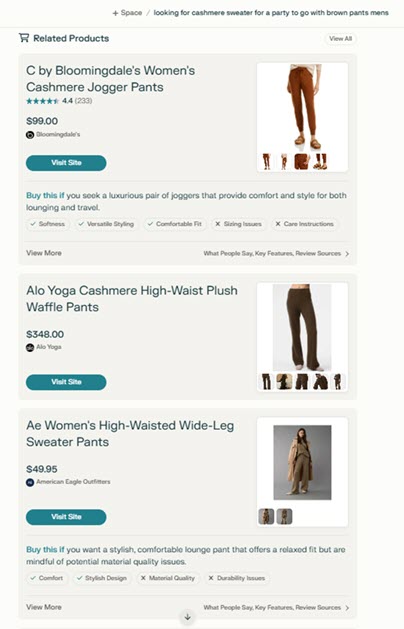
We started a new interaction with the identical prompt. This time, we received brown sweater suggestions, which is closer (do people wear brown sweaters with brown pants? maybe…), but still all women’s styles, while our user profile is configured as a male. So we should be receiving suggestions for men’s sweaters. Again, there were no Buy with Pro options, but we did find a Buy with Shop Pay option this time. Clicking the button brings the user to the Seller’s Shopify store directly to the checkout page to complete the purchase outside the Perplexity environment.
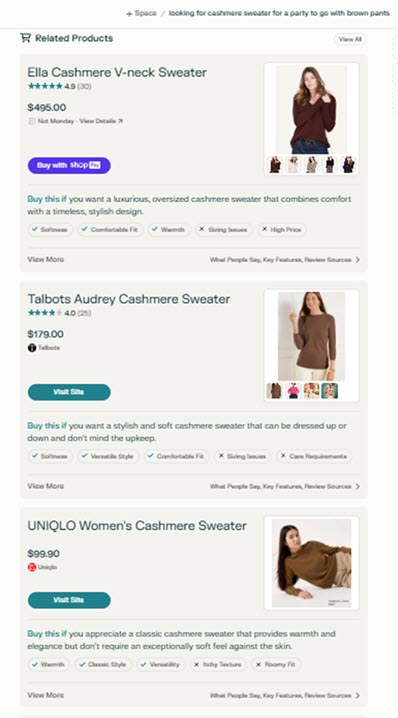
Looking for a New 3PL? Start with this Free RFP Template
Cut weeks off your selection process. Avoid pitfalls. Get the only 3PL RFP checklist built for ecommerce brands, absolutely free.
Get My Free 3PL RFPOn the third attempt, we appended the word ‘mens’ to the end of the prompt. This time, the results were mostly what we would expect, besides disagreement about what color sweaters would go with brown pants, though there was still no Buy with Pro option.
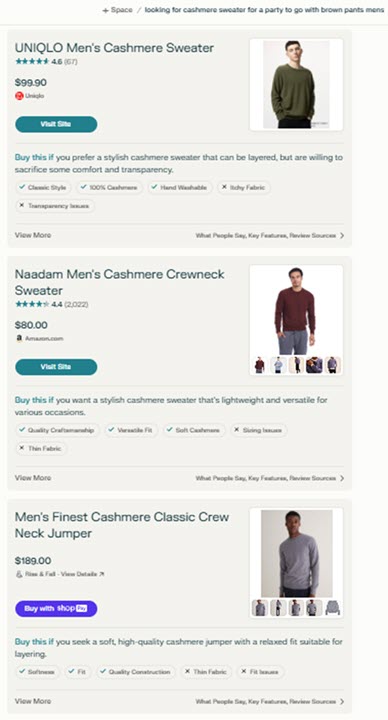
Perplexity Missed the Mark
While this use case for GenAI seems to be a natural fit for GenAI technology, it’s missing the mark. Search results were poor in our tests, suggesting product-market fit might be a long way away. The current solution lacks enough data or the needed intelligence or context.
We’re optimistic about the future of this technology, but in our limited trial/quick test, we weren’t impressed. Generative AI should be able to understand our profile and what we’re looking for and return a men’s sweater and not pants.
Scaling Made Easy: Calis Books’ Fulfillment Journey
Learn how Calis Books expanded nationwide, reduced errors, grew sales while cutting headcount, and saved BIG with Cahoot
See Scale JourneyIt Ain’t All Bad
While search results for the sweater didn’t deliver against expectations, the results did include some thoughtful suggestions about shades and tones to consider for different looks that the shopper might be interested in achieving, as well as tips for accessorizing the outfit:

So, there is promise, but is the product ready? We don’t think so. Again, it’s early, and this was our first couple of queries. But for paid Perplexity Pro users, that’s their first impression, and Shoppers will be disappointed, and Shoppers are very discerning.
Final Thoughts on Perplexity
Perplexity is still a young startup and may figure it out. But trying to compete with the OpenAI’s of the world and launching products prematurely may be a bad idea.
Whether expanding from the Shopify partnership to increase the scale of Buy with Pro or working on understanding the queries better and returning better results, the next move should be figuring out and bridging the gaps. In the era of AI, capturing interest and early users for only $20/month is the easy part. Keeping them, not so much. You can also listen to a recent Perpelixty AI Commerce Search podcast here .

Turn Returns Into New Revenue

Agentforce World Tour NYC
May 21, 2025 | Javits Center | New York, NY
Explore 180+ expert-led sessions, demos, and hands-on trainings. Learn how to power personalized data-driven agents that take action and drive results 24/7 across financial services, retail, media, and more.
Experience the latest agent-first innovation for your business live in NYC. All in one day, all for free.
Slash Your Fulfillment Costs by Up to 30%
Cut shipping expenses by 30% and boost profit with Cahoot's AI-optimized fulfillment services and modern tech —no overheads and no humans required!
I'm Interested in Saving Time and Money
Turn Returns Into New Revenue


